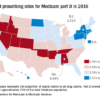Post-op remote monitoring may help catch drug errors, ease pain
NEW YORK (Reuters) – , a new study shows.
The analysis, of data from 905 patients who were randomized to receive either standard care or virtual care with the help of a remote automated monitoring (RAM) device, also revealed that fewer patients receiving virtual care needed to return to the hospital for acute care, researchers report in The BMJ.
“Among patients who undergo non-elective surgery – that is cancer, urgent or emergent surgery – and are discharged from the hospital, 24% come to the emergency room and 13% are re-admitted to the hospital within 30 days,” said Dr. P.J. Devereaux of McMaster University in Hamilton, Canada, a co-principal investigator on the study. “Moreover, 30% of patients go home with drug errors, and 60% and 45% have pain at 15 and 30 days after discharge and 27% and 20% have moderate to severe pain at these times, respectively.
“We demonstrated that virtual care with RAM technologies that measured heart rate, blood pressure, temperature, oxygen saturation, and body weight allowed for a large absolute difference in identifying the drug errors and corrected the errors (24% and 24%, respectively) compared to standard follow-up after hospital discharge,” Dr. Devereaux told Reuters Health by email. “Virtual care with RAM also resulted in substantial absolute reductions in pain at seven, 15 and 30 days of 14%, 12% and 10%, respectively.”
The study was carried out at eight acute-care hospitals, and the participants’ mean age was 63 years.
Each day the patients in the virtual-care group took biophysical measurements and completed a recovery survey, which were reviewed by nurses. Patients and nurses interacted daily through a tablet on days one to 15 and every other day from day 16 through day 30. On days without planned virtual visits, if participants’ biophysical measurements or recovery survey responses exceeded predetermined thresholds or nurses identified another reason for concern, the nurses organized unscheduled virtual visits.
During virtual visits, the nurses discussed the patients’ symptoms, obtained pictures and evaluated wounds. On days one, eight, 15, 22 and 30, drugs were reviewed. Care was escalated to preassigned doctors if the patients’ measurements exceeded predetermined thresholds, if specific symptoms were reported, such as syncope, if drug errors were identified or if the nurses had concerns about the patients’ health that they thought required a doctor’s attention.
In the virtual-care group, patients had access to a nurse or doctor 24 hours a day, seven days a week.
The number of days spent at home during follow-up was 29.7 in the virtual-care group and 29.5 in the standard-care group. Twenty-two percent of the patients in the virtual-care group required acute hospital care, as compared to 27% in the standard-care group (relative risk, 0.80; 95% confidence interval, 0.64 to 1.01).
Significantly more patients getting virtual care had a drug error detected (30% vs. 6%) and corrected (28% vs. 4%). In addition, as Dr. Devereaux noted, significantly fewer patients in the virtual-care group reported pain.
The beneficial effects appeared to be substantially larger in centers with a higher rate of escalation, the researchers found.
“Virtual care and RAM did not significantly increase days alive at home compared with standard care, but significantly improved detection and correction of drug errors and decreased pain,” they conclude.
Reuters Health Information © 2021


